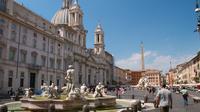Fountains and Squares of Rome 2-Hour Walking Tour Semi - Private
Rome, Italy
Rating: 









Trip Type: Private Day Trips
Duration: 2 hours
Explore the fountains and squares of Baroque and Renaissance Rome on a walking tour of two hours leading to some of the most famous places of the Eternal City. Admire the Trevi Fountain, see the ancient site of the Stadium of Domitian, and more.
More About This Activity All Private Day Trips →
Explore the fountains and squares of Baroque and Renaissance Rome on a walking tour of two hours leading to some of the most famous places of the Eternal City. Admire the Trevi Fountain, see the ancient site of the Stadium of Domitian, and more.
Explore the streets and fountains of Rome in a walking tour of 2 hours, combining art and architecture, legends and ice cream! Start in the Piazza di Spagna, at the base of the Spanish Steps. The 135 steps related to the historic Bourbon Spanish Embassy to the church of Trinita dei Monti at the summit. Designed by architects Francesco de Sanctis and Alessandro Mirrors, Spanish Steps it includes interesting Boat Fountain, the Baroque fountain in the shape of a half-sunken ship. Continue to the neighborhood to see the most famous Trevi fountain in Rome. Set against the Palazzo Poli, the Trevi Fountain attracts throngs of pilgrims who throw a coin into the water to ensure that one day return to Rome. Walk to the Pantheon, dedicated to the gods of Olympus and one of the best preserved monuments of ancient Rome. Once inside, you can admire the largest unreinforced concrete dome in the world. Next stop is the Piazza Navona, built on the site of the Stadium of Domitian. Now one of the most elaborate of the baroque squares of Rome, among its many highlights is Bernini's Fountain of the Four Rivers (Fountain of the Four Rivers). End in Campo de 'Fiori (Field of Flowers), already the site of a medieval market and used for public executions. In the center of the square you will see a bronze statue of the Dominican monk and philosopher Giordano Bruno, who was burned at the stake for heresy in 1600.
« Go Back

